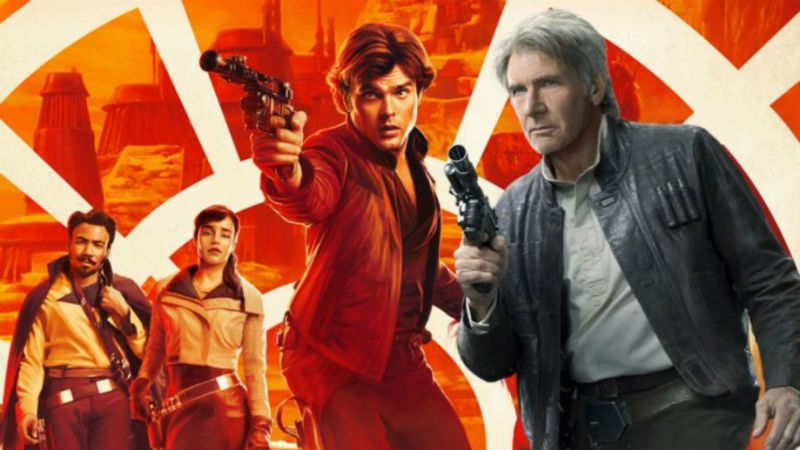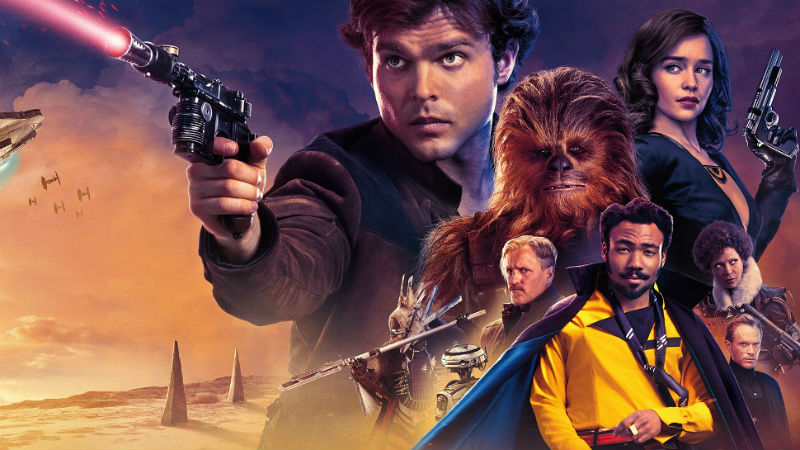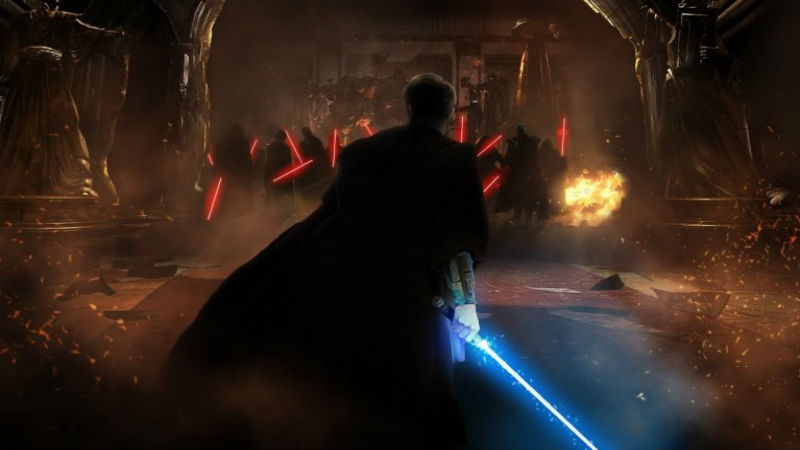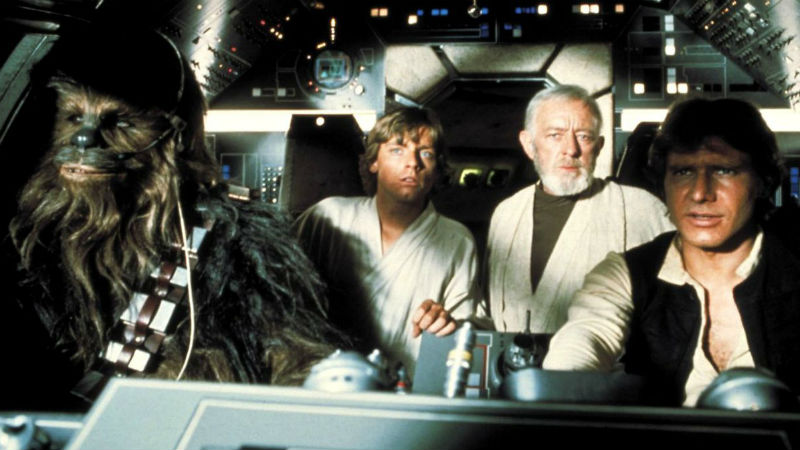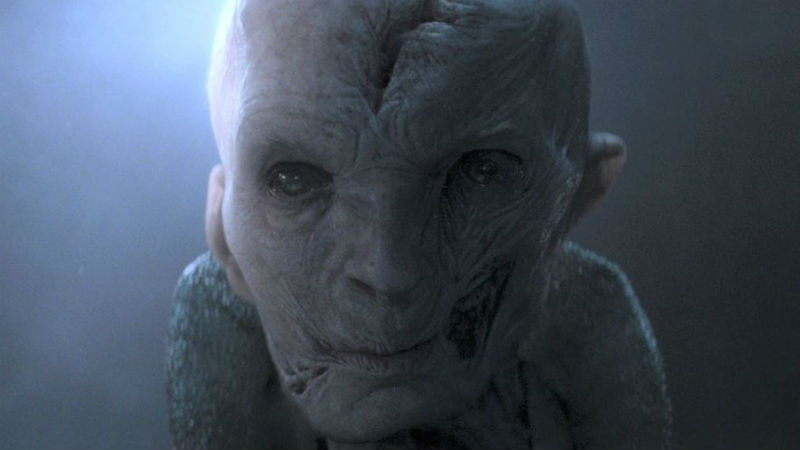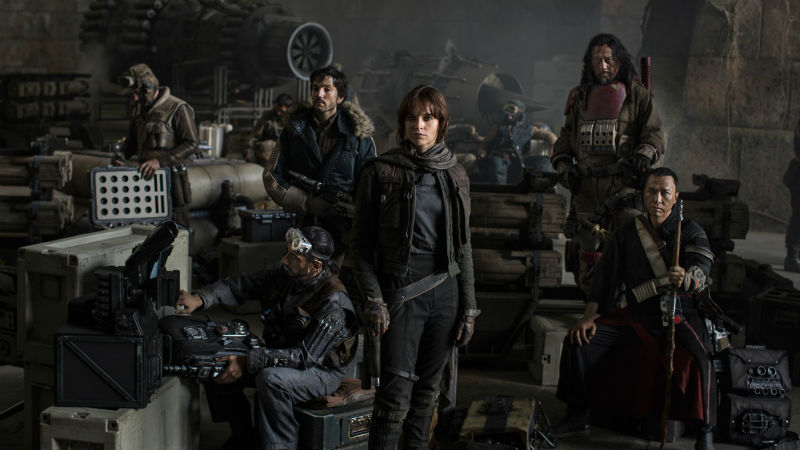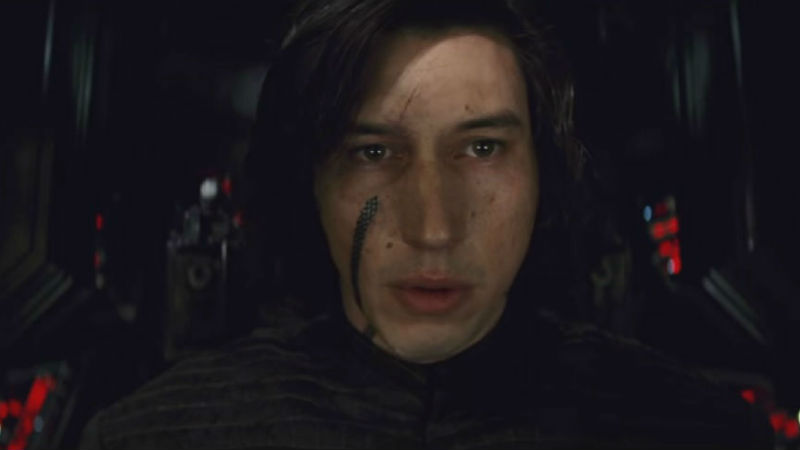WARNING: THIS ESSAY MAY CONTAIN MILD SPOILERS
There is a short documentary webisode that lies on the DVD extras of Star Wars: The Phantom Menace (George Lucas, 1999) that, thanks to YouTube, I often go back to. The scene begins on November 1st, 1994 and features George Lucas in his writing cabin beginning work on what will become the Prequel Trilogy of Star Wars films. He takes the camera crew around his den showing them his fresh paper pads and boxes of pens and his clunky desktop computer. He then collapses in his chair, exhausted by the prospect of writing these movies and sighs into the air “now all I need is an idea.”
What fascinates me about this footage is the fact that Lucas set out to write a film series that wouldn’t see the light of day for another five years. The Phantom Menace hit theatres in May 1999 and the subsequent films would be spread out over a further six years, with Attack of the Clones coming in 2002 and Revenge of the Sith [pictured below] in 2005. The Prequel Trilogy represents over a decade of dedication, not just Lucas’s part, but a whole team of creatives. As Lucas comments in the same clip “It starts with me sitting here doodling in my little binder but it ends up with a couple of thousand people working together in a very tense, emotional, creative way.” The Prequel Trilogy, despite its faults in direction, pacing, dialogue delivery, acting technique, racist stereotyping, and narrative elements that hinders the overall arc of Darth Vader’s origins, it has stood the test of time and like the Original Trilogy have become cinematic classics that have found a new life in the online world of memes and Reddit and YouTube theory posts. The dedication to scope, world-building, and mythology that might have slowed the films down to a death crawl has actually paid off.
Let’s talk a bit about about slow. Though I’m sure he wasn’t thinking of it at the time, Lucas’s decade long endeavour is an excellent example of the slowness philosophy that is often applied to other outlets: slow cooking, living, parenting, teaching, travel, and technology. The slow philosophy promotes attention to detail, to savour the moment, to experience something at a leisurely pace. These are attributes that rarely apply to blockbuster cinema. Knowing that a decade of one’s life is going to be set aside for the writing and production of three sci-fi fantasy movies is impressive, but what is more impressive is Lucas’s 15-year gap between the Original and the Prequel Trilogies. Star Wars was all but a forgotten pop-culture artifact when Lucas decided to resurrect it in the mid-1990s.
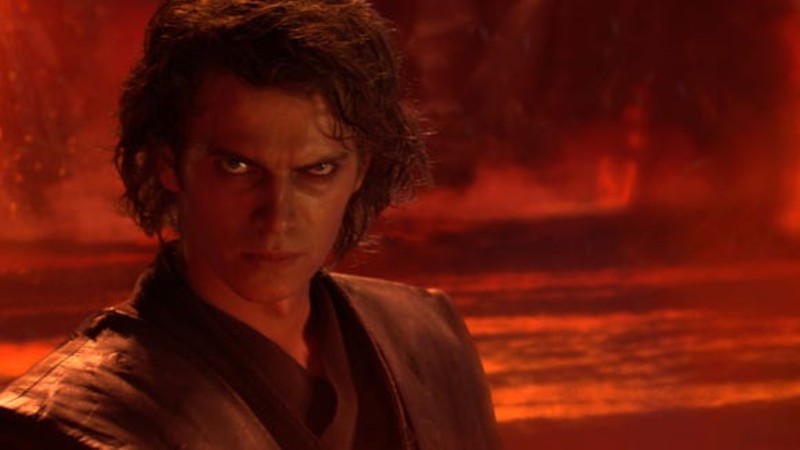
.
Fast forward to the present
Our times are not the same as George Lucas’s heyday. When Disney purchased the Star Wars brand towards the end of 2012 the entertainment conglomerate pushed to have the new Star Wars films in theatres with almost immediate effect.
The first of the Sequel Trilogy, Star Wars: The Force Awakens {J. J. Abrams) came in 2015. Since then a Star Wars related film has been released every year. Rogue One: A Star Wars Story (Gareth Edwards) followed in 2016, Star Wars: The Last Jedi (Rian Johnson) in 2017, Solo: A Star Wars Story (Ron Howard) in 2018 and finally as 2019 closes, Star Wars: The Rise of Skywalker (J. J. Abrams) [pictured at the top and the bottom of this article] rounds off the Skywalker Saga. What took Lucas 28 years to complete with his two trilogies Disney has managed (minus one film, though the Disney+ show The Mandalorian is arguably an epic film-like production) in five.
I’m raising this point for a number of reasons. Firstly, the nature of cinema has accelerated to the point of almost exhaustive collapse. The Star Wars franchise is an excellent case in point but look to the Marvel Cinematic Universe for an even more hyperreal example. The first two phases, beginning with Ironman in 2008 (Jon Favreau; pictured below) and ending with Ant-Man (Peyton Reed) in 2015 saw 12 films issued, six films per phase. Twelve films over seven years is somewhat excessive, but no way in comparison to Phase 3 of the MCU, which unleashed 11 films in the space of four years. Secondly, the “quality over quantity” aspect of slowness has been reversed in this new accelerated cinematic landscape and the Sequel Trilogy and the Star Wars anthology films have been critically shredded and in some cases angrily dismissed by the fan base. All aspects of Disney’s production, from story to direction, art design to acting, casting to costume, editing decisions to the script has been dissected, ridiculed, memed, criticised and dispatched. A cottage industry has developed in which fans of the franchise call Disney out in public. Some of this criticism is justified – the narrative swerves and odd characterisation seen in The Last Jedi is somewhat meta for a blockbuster movie, whilst some of this criticism is uncalled for and downright cruel – the hounding of the films female actresses for example.
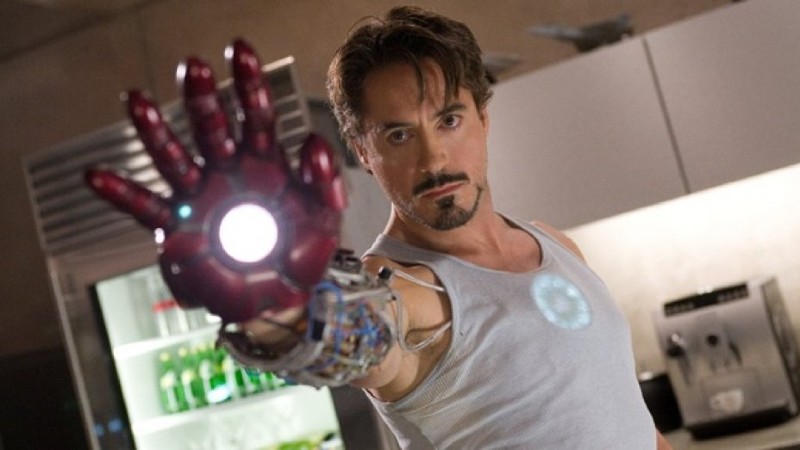
.
All downhill from here?
Despite my admiration and even genuine like of the Sequel Trilogy, I realise something is off. There is a hollowness and lack of depth to the overall arc and coincidence and convenience has replaced storytelling in order to make the narrative of this trilogy happen. There is also the mismatched direction of J.J Abrams and Rian Johnson that barely correspond to each other with any fluidity. Though the Original Trilogy had different directors for each film, George Lucas was the overseer in creating a consistent set of movies. Here Abrams and Johnson have set out agendas and arcs only to retract, change, or ignore them completely. These elements might be answered in books, TV shows, cartoons, comics, and games, they will certainly be debated ad nauseum for years to come by Star Wars YouTubers and Reddit threads.
The Rise of Skywalker arrives with diminished fanfare and an expectation that the film will be a disappointment in some way or another. Script leaks captured early criticism and the recovery is not yet in sight. I’ll not divulge the narrative or offer a review as such. These have been offered in countless forums across the internet. What I want to discuss are elements of the film that hinders its overall impact as a film and a conclusion.
The film suffers from plot devices (I’m refusing to use the term ‘McGuffin’ though that is what they are), thrown in simply to get the action rolling at a chaotic pace. A Wayfinder device, an ancient dagger, an old adversary, a revealed heritage, the introduction of new (and old) characters, and new and unexplained Force abilities. In themselves, these are not bad ideas. What they are are underdeveloped ideas, ideas which would have benefited from inclusion and explanation way before this film. Suddenly, and as a reaction to the swerves taken in The Last Jedi, a whole new narrative apparatus has had to be created in order to get one movie on track towards the whole saga’s conclusion. It’s an exhausting experience that leaps from one planet to another at dizzying speed. Time accelerates in this film’s presence.
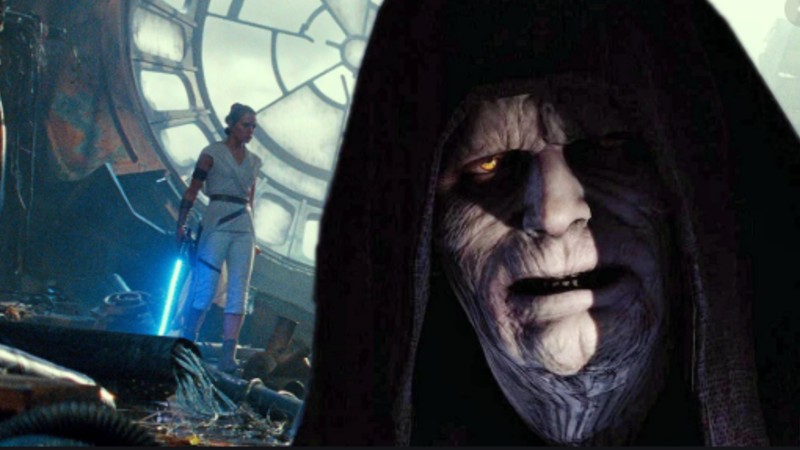
The quite literal resurrection of Emperor Palpatine [pictured above] for the final chapter is welcome only due to that particular character’s utter and delirious wickedness. In reality, it makes little sense and is never really explained, and despite denials from Abrams, the inclusion is an obvious quick fix for Johnson’s despatch of Supreme Leader Snoke in The Last Jedi. We’re led to believe Palpatine has been pulling the strings for the past three decades and with only a few flourishes of dialogue the whole dilemma is snuffed out without question.
Character arcs and actions are redundant or unbelievable. Many complained (including Mark Hamil himself) that Luke Skywalker’s grizzled and downtrodden turn in The Last Jedi failed to correspond with Luke’s optimistic and adventurous persona in the Original Trilogy. In The Rise of Skywalker, characters we’ve been shown to be egotistical devils are suddenly performing actions contrary to this perception. Take, for example, General Hux. In The Force Awakens, Hux is a proto-fascist zealot of the dreaded First Order. A man whom with spit in his mouth and tears in his eyes directs a destructive laser towards the heart of the New Republic government planets and snuffs out potentially billions of citizens. In The Rise of Skywalker, he turns his back on the First Order and allows our heroes to escape and set about the destruction of the First Order. This is not a realistic action of a character we’ve come to know as a snivelling repellent. It is an action that is nonetheless required by the script to get one set of characters from A to B.
And whilst the characters may physically move from A to B, their actual emotional arcs are pretty much stuck. The main character of Rey, for example, has garnered many Force abilities and earned wisdom from her adventures. But, ultimately, she ends up where she began the trilogy, alone on a desolate backwater desert world staring off into the horizon not really knowing her path. In the Original Trilogy, there was knowledge that Luke, Han, and Leia had weathered many crises in the intervening years between episodes. During the Galactic Civil War, there was genuine loss and upheaval. The end of the Original Trilogy showed (thanks to the 2004 Special Editions) citizens celebrating the end of the Empire across many different worlds. It was a universal victory. In The Rise of Skywalker, the victory, if there even is one for the galaxy, is far more subdued and personal. Has Rey really won a galaxy? Will she lead a new collective government of begin a new Jedi Order? Her story ends at the pinnacle of a new dawn with no victors as such and raises more questions for the wider galaxy than it can answer. Judging by some of her questionable Force actions (she shoots bolts of Sith lightning and destroys a ship supposedly holding her conrade), she might even be a future danger to the galaxy.
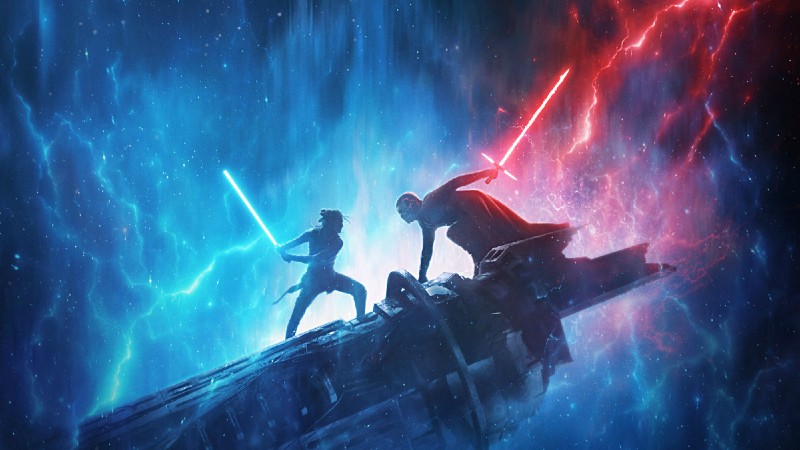
.
Not all doom and gloom
The only character arc that is worth the whole saga is that of Kylo Ren/Ben Solo. As the main protagonist, Ren has carried a weight around his neck and his physical self seems in constant turmoil. When he succumbs to the Light Side as Ben Solo his whole body language and facial expressions become as light as a feather. His whole persona in the last half of the film is one of relief and we feel it with him. In this case Adam Driver really deserves the praise that has been granted him for this performance.
Criticism can be placed at George Lucas’s feet for many problems seen in past Star Wars movies. But his consistency in epic storytelling and worldbuilding was at least an asset. In The Rise of Skywalker, and the Sequel Trilogy as a whole, the whole galaxy seems smaller and you get the impression most have given up on the outcome of this conflict and that the battles are being fought on a much smaller scale in some deadbeat part of the galaxy. It is a reaction many audience members will also feel.
I will say The Rise of Skywalker offers the most complete Star Wars experience seen on screen since Revenge of the Sith, but its placement as a final chapter in the saga is ultimately redundant because of the previous inconsistency of The Force Awakens and The Last Jedi and now this film’s inconsistency to those films and the other trilogies. It doesn’t feel connected to past films. As a standalone film, The Rise of Skywalker is a treat, a rollicking adventure that twists and turns, offers plenty emotional gut punches, nostalgia kicks, and never for a moment bores. But it’s too little too late. The goodwill has been exhausted. The acceleration to rebirth Star Wars to a new generation is obviously rooted in firstly, making fast bucks, secondly, pushing merchandise and toys, and thirdly, signing up new subscribers to a streaming service. Intricate layered storytelling and gradual worldbuilding have been abandoned in this quest.
As a film, The Rise of Skywalker might stand as the final word in the Skywalker Saga, but what it should’ve been is the first word in a far broader and more expansive and diverse universe that was hinted at in The Last Jedi. But as the trilogy, and an entire saga is now at its end the roots have been severed from any potential future. Although I’m as eager as any Star Wars fan for more content, you wish in retrospect Disney had taken a leaf from Lucas’s book and just slowed down.









